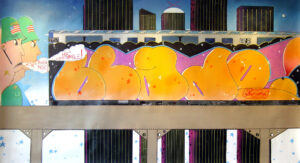i begyndelsen af 1979 sad komet og blade tilbage og reflekterede over deres fantastiske graffiti-karrierer. siden 1972 anslog hver forfatter, at de havde lavet 5.000 stykker. klinge mindede denne figur ved at lave et ende-til-ende-stykke, hvor der stod “stykke nummer 5.000”. parret var blevet så kede af det i 1979, at de tyede til gadebombning (upopulært på det tidspunkt), ristede små dele af byen ud og mærkede alle de gode steder. men selv med denne nye afledning kedede de sig stadig. en nat på esplanade lay-up stødte de på fire biler nymalet af mta, hver forfatter malede to-bil-orme med deres navne i fede bogstaver. det var en fantastisk præstation, og deres jævnaldrende lagde mærke til det.
kort efter at have udført de nu berømte helbiler, kom kometen og bladet tilbage på esplanaden for at male flere tog. de fire berømte biler var der også, og da forfatterne nærmede sig for at få et nærmere eftersyn, blev de mystificerede. nogen havde streget over de to komet-helbiler, og den stødende maling var stadig våd. ved at søge gennem la-up’en fandt de to forfattere til sidst gerningsmændene og kometen tilbød at bekæmpe dem begge. mens stillingen gik frem og tilbage, blev bladet blændet, mens det stod på toppen af et af togene. ramt på siden af hovedet med en tung stok, faldt han bevidstløs ned på sporene nedenfor. som han fortalte senere “det var skørt, og virkelig fejt, mit hoved landede lige ved siden af den tredje skinne, og jeg kunne høre den brummende lyd af elektriciteten.” komet var i stand til at hjælpe blade hjem, hvor han var sengeliggende i to uger.
at der kunne komme noget godt ud af dette, er den forløsende del af historien. Blade havde tegnet sine drømme efter råd fra sin kæreste i de sidste to år, og nu, med intet andet end tid på hænderne, tog han sine bedste tegninger frem og tilpassede dem lige til togene. billederne var panoramiske i omfang, og da han lagde sig i sengen, begyndte han at notere de nøjagtige farver, han skulle bruge for at trække dem af. noget af malingen havde han i forvejen, og noget skulle stadig kasseres.
i slutningen af 1979 gik blade til esplanade-lay-up og trak en række hele biler ud, der er blevet ikoniske emblemer for det bedste, metrobevægelsen havde at tilbyde. nogle af togene, som “the walking letters”-vogn, havde en lang levetid, mens andre, som “på tværs af universet” kun holdt en uge. hvilke tog, der blev berømte og forblev i tjeneste, og hvilke tog ikke gjorde det, var alt sammen et lortskud. noget overladt til graffitiens vægelsindede guder. uafskrækket af forgængeligheden af hans mesterværker, blev klinge ved med at male, hvilket øgede hans antal på 5.000; “Jeg tror, at meget af det bare var momentum, efter at jeg fik gangbogstavsbilen, fik jeg en fantastisk respons fra de gamle skoleforfattere, som gerne ville se mere som den, som gav mig lyst til at gøre den næste bil endnu bedre.”
uden for graffitibevægelsen var to fotografer, som var passende imponerede over blades nye værker, deres navne var marty cooper og henry chalfant. begge fotografer dokumenterede bladmalerierne, og i 1984, med udgivelsen af deres banebrydende værk undergrundskunst, blev værkerne set rundt om i verden og var med til at lancere en global graffitibevægelse. Hvad angår komet og klinge, fortsatte begge forfattere deres karriere indtil 1984, før de bukkede under for den fine kunstverden.




